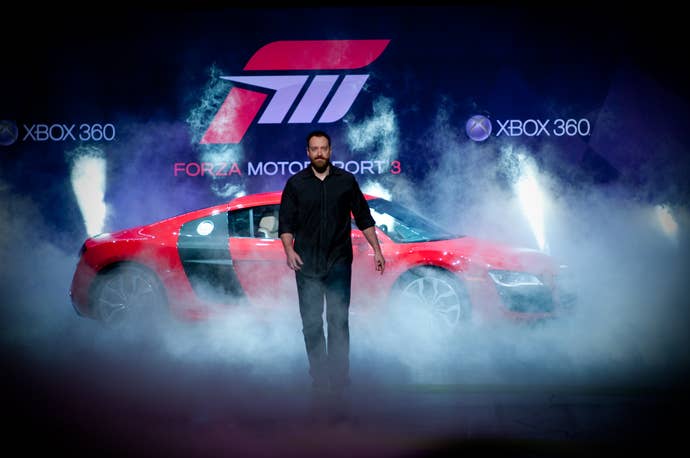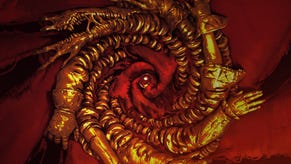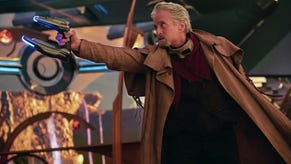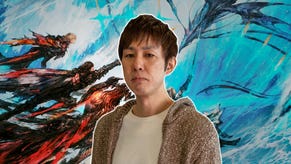How Microsoft's Scientist of Speed Turned a Business Strategy into a Great Series
Eurogamer's Martin Robinson tells the story of Forza Motorsport and the man behind it.
This article first appeared on USgamer, a partner publication of VG247. Some content, such as this article, has been migrated to VG247 for posterity after USgamer's closure - but it has not been edited or further vetted by the VG247 team.
Dan Greenawalt rolled his first car before he ever got a chance to have his way with it.
A '73 Volvo 145 station wagon, it was a victim of the young driver's rash love of stepping its sizeable tail-end out. "It was rear-wheel drive and had loads of weight at the back, so it was great for drifting," he says, his big blue eyes softening at the recollection.
Greenawalt had been raised in a working class Pennsylvania family where tinkering under the bonnet was to become second nature. His passion wasn't necessarily for the cars, but for making them better -- getting beneath their skin, understanding how they worked and then figuring out how to make them run more efficiently and, more importantly, faster.
Today, that youthful flash of recklessness comes as something of a shock. As the creative director and most visible spokesperson at Turn 10 studios, Greenawalt's a man of neat logic. You can sense that much upon meeting him, his ink-black shirt perfectly pressed, his hair cut to the scalp, his beard impeccably trimmed. You'll get that from his conversation -- steady, thoughtful and always working towards a grander point - it carries the practised cadence of at once a lecturer, a salesman and a patient evangelist.
You'd maybe get that much if you've ever played any of the Forza Motorsport games that Greenawalt looks over. To call them sterile would be cruel, though they're certainly surgical in their packaging of car culture, and in their simulation of real world physics. Since Forza's inception during the original Xbox's reign, Greenawalt and Turn 10 have created a series that's renowned for detail and for its peerless production values. Just over eight years since Forza Motorsport first released, the franchise now sits alongside Halo as one of Xbox's most valuable assets.

10 years ago, Forza was born out of a business strategy conjured by a company hungry for the mainstream successes that Sony's PlayStation was enjoying. "There was an interest in Microsoft Game Studios to have something for the platform that would oppose Gran Turismo," explains Greenawalt. "Now, I don't find that creatively inspiring, but as a strategy that gives me a lot of creative wriggle room to live in.
"Strategically they needed a car thing to oppose that game -- but they weren't saying what it should or shouldn't be. I very much had a vision -- a passion -- for actually making games that would make a difference to car culture. It's something I'm famous for saying -- get gamers into cars, and car lovers into games. It's just a statement, but it was my North Star even then -- I thought this idea of there being arcade games and there being sim games, I thought that was bullshit. I thought we could do better as designers."
Greenawalt's own path to becoming a designer is a curious one. A background in mixed martial arts pushed him towards teaching it, an ambition that ran in parallel to his studies in comparative religion at Colorado College in the mid-90s. "I loved martial arts. I taught and I competed," says Greenawalt. "Being a comparative religion major didn't hurt my career, because I wasn't going to make that my career."
His major did teach him something else, though, that would give him the grounding in the diplomacy required to head up a team within Microsoft Game Studios. "You learn a great respect for the diversity of humanity. And you learn that it's okay to be wrong, and actually maybe a little bit nihilistically you come to believe -- or I came to believe -- that in essence everyone is wrong, including myself, and that's just okay. It's a very liberating feeling.
"The truth is, it makes for great game design. Realising that you're not going to be the one with the right answer makes you collaborative. Also, respect for a diverse group of people makes it so you can start to see trends, and rather than being blinded by your own beliefs you sort of say, 'Oh, that looks like a pattern, let's look into it, let's research it.' But also remaining emotional -- understanding that it's not empirical; people have feelings, they have faith and they have beliefs. I mention that, because that background makes me a stronger designer."
It took the belief of others for Greenawalt to start a career in game design. After university, he pursued his dream of teaching martial arts, first in Colorado and later in Los Angeles before settling back in Seattle. It was there, having begun to face the difficulties of setting up his own school, that he took a second job at Microsoft under the advice of a friend in order to fill the hours between lessons.
He found himself as a tester within a company in hyper-drive as it worked towards the release of its first dedicated games console, and where there was a flexibility with job roles. Working on basketball simulator Inside Drive -- alongside Bonnie Ross, who would later go on to take a senior role at 343 Studios -- Greenawalt found himself gravitating towards a different line of work.
"Even as a tester I was starting to do design. Everyone says they want to be a designer. The real question is, does everyone else want you to be a designer? I didn't necessarily want to be a designer, but I was making certain suggestions -- and I wasn't like, 'You've got to do this!' That's not who I am. I was just saying this might make it better, take it or leave it. The next thing I know they were having me do things, managing the tuning of all the player bases." Greenawalt's next project would see him begin to move up in Microsoft's hierarchy, and would take him a step closer to his calling.
Coming from a family accustomed to carburettors and driveshafts, Greenawalt's interest in automobiles was endemic of being raised in a community where working with cars was often the only way to earn money. "I was mechanical rather than a mechanic. And the guy that taught me cars, he was a great mentor. I did a bit of racing when I was young, but nothing serious -- it was just racing on roads with other assheads."
After the altercation with the Volvo, Greenawalt moved on to more involved projects. A '73 Toyota Corolla, picked up for $250 from an owner who just wanted the sickly machine out of his yard, required a complete rebuild, inspiring Greenawalt to move above and beyond the basic specification. Later, more serious machines such as a Mitsubishi 3000 GTO and Audi S4 would let him fully indulge his love for tuning.
At Microsoft, where he was set to work on Midtown Madness 2, it's an affinity that saw him peeking under the bonnet, leaning on science classes he took to boost his GPA while studying at Colorado to help him tune the physics within the game. Soon afterwards, Greenawalt was parachuted into Bizarre's Liverpool studio where he worked on Xbox launch title Project Gotham Racing.
"I loved the guys there. [Studio founder] Martyn Chudley was a mentor to me -- he took me under his wing and I learnt incredibly valuable experiences on that title. Some they wanted me to learn, and some where they would probably have disagreed with what I learned -- and part of that was being in the role of being on the publisher side rather than the developer side."
"Car games are about more than racing. They're about cars! And racing's just part of that. Racing's just the spoke, not the hub."
Dan Greenawalt

Greenawalt was still officially working as a game tester, but as his role developed so too did his attitude towards his work. His martial arts teaching, which he had continued in Liverpool, came to an end, and his input on the first Project Gotham Racing was eventually rewarded with a design credit on the game.
"I didn't ask for that, and I didn't call myself a designer, but they'd called me a designer. That was the first time I realised that this might be something that I'm good at. Not just that I think I'm good at, but that others think I'm good at. That's really what turned my job into a career -- that time in Liverpool, the mentorship from Martyn, shipping a game at launch. It was f**king hard! That's hard, hard work. But it was so exciting -- I love hard challenges."
Back in Redmond, Microsoft was preparing a new challenge. Thanks to games like Halo and, of course, Project Gotham Racing, the Xbox was gaining momentum, looking like a respectable competitor to the PlayStation 2. But it lacked something that would give Xbox the broad, mainstream appeal of Sony's machine: it lacked something like Gran Turismo.
A small group was formed to address the problem, bringing together Project Gotham Racing's project manager, Rallisport Challenge's publishing art lead and a development manager. Also in that team was Greenawalt, still fresh from the experience of working at Bizarre.
"The space we had was not a vision -- it was a business strategy, it had room for long-term and it had aspirations business-wise. But that's not what we build. We don't build the business -- we build the project, we build the game and we build the community to play it," says Greenawalt. "The four of us were the ones who came together and took that general strategy and turned it into a creative strategy, and that's very different. It's one thing to say you need to work in this space, it's another thing to say we're going there. To me, competition isn't where we were going."
The vision was for a broader, more approachable driving game, and one that allowed its players a greater sense of expression. Forza Motorsport was to popularize the virtual driving line, a simple thread overlaid on tracks showing drivers the optimal brake and turn-in points, while introducing a detailed livery editor that would remain at the heart of all subsequent installments.
"I believed that if we made games that were truly configurable and could learn a little about you -- and if we could use the ideas, and this will date me, of web 2.0 -- I said with the original Forza take these ideas of crowdsourcing, creativity and web 2.0 and have things like the livery editor. Car games are about more than racing. They're about cars! And racing's just part of that. So what's the hub and what's the spoke? Racing's just the spoke, not the hub - that's the car."
"The group, once I started speaking that way, was like, that sounds great. At that point we had the budget to start adding heads -- so we added a physics dev, and we started growing the team. Most of the guys we added, it was a 50/50 split, from Microsoft and not from games, or from games and not from Microsoft. And that blend was very powerful -- very creative, very willing to challenge the norms of Microsoft. And we started creating our own culture internally. We went into a greenlight, and about 15-20 people built a greenlight build."
"We are pushing science in ways that genuinely are not pushed by games. We're creating the engineers of the next ten years."
Dan Greenawalt
Forza Motorsport benefited from Microsoft's near-bottomless resources, as well its expertise: AI was developed with the help of Microsoft Research in Cambridge, while Chris Tector built the game engine from scratch in his role as chief architect - a position within Turn 10 that he remains in to this day.
The results were fantastic -- going up against a Gran Turismo series that many felt was stagnating, Forza Motorsport reinvigorated the genre and, true to its brief, broadened the appeal of driving games. It's a success that has carried on ever since, each instalment growing in stature -- and its remit being widened, thanks to Gavin Raeburn, Ralph Fulton and the team at Playground Games, to open world driving in last year's Forza Horizon. It's a success that Turn 10's hoping to consolidate with the release of Forza Motorsport 5, perhaps the Xbox One's most high-profile launch title.
So when exactly did Forza Motorsport escape the stigma of being a franchise set up to rival Gran Turismo? "It was the green light," says Greenawalt, who's understandably tired of swatting away comparisons between the two. "Honestly, the green light -- before Forza Motorsport launched. It wasn't the inspiration -- it just carved out a business space."
He's right, of course: from day one, Forza Motorsport's had its own identity and, no matter where you stand on the depth of its car list or the feel within its handling, it's hard to deny that it's been consistently the better game than Sony's series. Still, there are interesting parallels to draw, and as Polyphony moves from reflecting the automotive industry to becoming deeply embedded within it, it's fascinating to see where Turn 10 is taking Forza.
"I think there's a difference between marketing and true influence," Greenawalt says of Gran Turismo's initiatives such as the GT Academy and Vision, a slight fire igniting beneath his otherwise calm persona. "And I'm just being honest. Our AutoVista was used for the board of directors for a certain car company -- and I'm not going to name the company, because this isn't marketing -- our AutoVista was used to show new cars to their board of directors. We didn't do that for marketing purposes. We did it because they asked."
It's not marketing, insists Greenawalt, but he still works hard to sell the vision of Forza Motorsport. A partnership with Calspan has given Turn 10 a deeper understanding of tire simulation than, as Greenawalt's been keen to say in pre-release presentations, the tire manufacturers themselves.
"Obviously that's a bit glib," he admits away from the stage. "Pirelli obviously knows more about their tyres than we do. It's a turn of phrase to say there are aspects of simulation, and it's not their business to know. And no-one knew it, so we're being pioneers in that. When I say the word pioneer, I'm not trying to compare myself to the Pilgrims. That's just bullshit. But we are pushing science in ways that genuinely are not pushed by games. We're creating the engineers of the next ten years. They're going to be reading our textbooks."
That over-eager kid that rolled a Volvo on to its roof has, in a relatively short time, helped flip the driving genre on it head, and as a designer whose 10 years at Microsoft have made him equal parts salesman and scientist, he retains that same sense of overbrimming enthusiasm. And beyond that there's the passion of the eternally curious; all these years later and Greenawalt's still under the bonnet looking for where to tinker, and for ways to go faster.










_ddwYK80.png?width=291&height=164&fit=crop&quality=80&format=jpg&auto=webp)